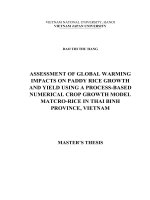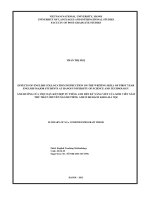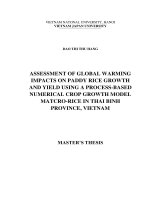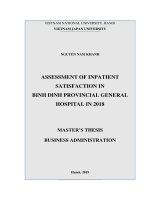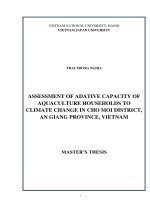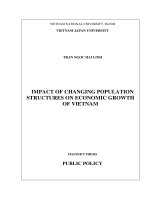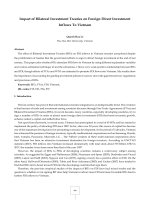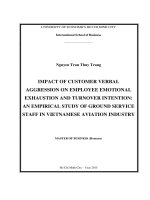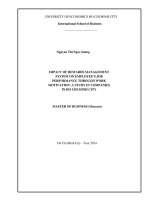(Luận văn thạc sĩ) assessment of global warming impacts on paddy rice growth and yield using a process based numerical crop growth model matcro rice in thai binh province, vietnam
Bạn đang xem bản rút gọn của tài liệu. Xem và tải ngay bản đầy đủ của tài liệu tại đây (1.47 MB, 55 trang )
VIETNAM NATONAL UNIVERSITY, HANOI
VIETNAM JAPAN UNIVERSITY
DAO THI THU HANG
ASSESSMENT OF GLOBAL WARMING
IMPACTS ON PADDY RICE GROWTH
AND YIELD USING A PROCESS-BASED
NUMERICAL CROP GROWTH MODEL
MATCRO-RICE IN THAI BINH
PROVINCE, VIETNAM
MASTER’S THESIS
VIETNAM NATONAL UNIVERSITY, HANOI
VIETNAM JAPAN UNIVERSITY
DAO THI THU HANG
ASSESSMENT OF GLOBAL WARMING
IMPACTS ON PADDY RICE GROWTH
AND YIELD USING A PROCESS-BASED
NUMERICAL CROP GROWTH MODEL
MATCRO-RICE IN THAI BINH
PROVINCE, VIETNAM
MAJOR: CLIMATE CHANGE AND DEVELOPMENT
CODE: 8900201.02QTD
RESEARCH SUPERVISOR:
Associate Prof. Dr. YUJI MASUTOMI
Associate Prof. Dr. MAI VAN TRINH
Hanoi, 2020
PLEDGE
I assure that this thesis is the result of my own research and has not been
published. The use of other research’s result and other documents must comply with
regulations. The citations and references to documents, books, research papers, and
websites must be in the list of references of the thesis.
AUTHOR OF THE THESIS
DAO THI THU HANG
i
TABLE OF CONTENTS
PLEDGE .................................................................................................................... i
LIST OF TABLES .................................................................................................. iv
LIST OF FIGURES ..................................................................................................v
LIST OF ABBREVIATIONS................................................................................. vi
ACKNOWLEDGEMENT ..................................................................................... vii
ABSTRACT ........................................................................................................... viii
CHAPTER 1. INTRODUCTION ............................................................................1
1.1. Overview ......................................................................................................1
1.2. Research objectives ......................................................................................4
1.3. Structure of the Thesis ..................................................................................5
1.4. Learning Outcomes ......................................................................................7
CHAPTER 2. METHODOLOGY .........................................................................10
2.1. Framework of the study ..............................................................................10
2.2. Study area ...................................................................................................12
2.2.1. Location ..............................................................................................12
2.2.2. Climate ................................................................................................13
2.2.3. Rice variety (Bac Thom No. 7 cultivar_BT7) .....................................17
2.3. MATCRO-Rice model ...............................................................................17
2.4. Data sources ...............................................................................................20
2.4.1. Meteorological data ............................................................................20
2.4.2. Crop management ...............................................................................21
2.5. Model parameterization ..............................................................................23
2.5.1. Phenology............................................................................................23
2.5.2. Dry matter Partitioning ......................................................................25
2.6. Nitrogen response .......................................................................................25
2.7. Model validation.........................................................................................27
2.8. Global warming impact assessment ...........................................................27
CHAPTER 3. RESULTS ........................................................................................29
3.1. MATCRO-Rice parameterization and validation ......................................29
3.1.1. The effect of parameterization to phenology ......................................29
3.1.2. The effect of parameterization to Carbon partitioning .......................31
3.2. Yield and nitrogen response .......................................................................34
3.3. Impact of temperature increase on rice yield .............................................36
CHAPTER 4. DISCUSSION AND LIMITATION ..............................................38
4.1. Discussion ..................................................................................................38
4.2. Limitations..................................................................................................41
ii
4.2.1. Data gaps ............................................................................................41
4.2.2. Limitation of the parameterization .....................................................41
CHAPTER 5. CONCLUSION ...............................................................................42
REFERENCES ........................................................................................................43
iii
LIST OF TABLES
Table 2.1. Thai Binh province weather by month and weather averages ................15
Table 2.2. Site information and input .......................................................................18
Table 2.3. Meteorological variables ........................................................................20
Table 2.4. Information of Site 1 and Site 2 ..............................................................21
Table 2.5. Crop calendar and field measurements ...................................................22
Table 3.1. Comparison of development stage index between simulation and global
...................................................................................................................................29
Table 3.2. Timing of growth date (mm/dd/yr) .........................................................29
Table 3.3. Partitioning parameters............................................................................33
Table 3.4. The difference between before and after calibrated nitrogen response
index ..........................................................................................................................34
Table 3.5. Percentage different between observed and simulated yield ..................35
Table 3.6. The statistical analysis of rice yield ........................................................35
Table 3.7. Influence of temperature increase on rice yield ......................................37
Table 4.1. Yield reduction ........................................................................................40
iv
LIST OF FIGURES
Figure 2.1. Framework MATCRO-Rice model simulation .....................................11
Figure 2.2. Map of Thai Binh administrative regions ..............................................13
Figure 2.3. Monthly average temperature (oC, line and left vertical axis) and
monthly rainfall (mm, column and right axis) ..........................................................14
Figure 2.4. MATCRO-Rice model structure............................................................18
Figure 2.5. The relationship between specific leaf nitrogen and DVS ....................27
Figure 3.1. Heading date of simulation and global data ..........................................30
Figure 3.2. Heading date of simulation and global data ..........................................31
Figure 3.3. Partitioning ratio of glucose to organs including leaves (a), panicles (b)
within shoots and root (c) ..........................................................................................33
Figure 3.4. Correlation between the observed and simulated yields. The orange line
is the 1:1 line .............................................................................................................36
Figure 3.5. Comparison between simulated yield, yield at 4 warming scenarios
applied for 3 nitrogen cases (high, medium and low) ...............................................37
Figure 4.1. Menu for adaptation options on agriculture...........................................39
Figure 4.2. Influence of N fertilizer levels on rice yield at different temperature
increase scenarios ......................................................................................................40
v
LIST OF ABBREVIATIONS
CGM:
DVS:
GSO:
hGDH:
mGDH:
MONRE:
RRD:
SLN:
UNFCCC:
Crop growth model
Development stages index
General statistic office
Growing degree hour from seedling to heading
Growing degree hour from seedling to harvest
Ministry of Natural Resources and Environment
Red River Delta
Specific leaf nitrogen
United Nations Framework Convention on Climate Change
vi
ACKNOWLEDGEMENT
I would like to express my sincere gratitude to my supervisors Dr. Yuji
Masutomi - Ibaraki University and Dr. Mai Van Trinh - Director of Institute for
Agricultural Environment for providing the invaluable guidance, comments and
suggestions throughout my thesis.
I would special thank Dr. Akihiko Kotera for scientific consulting and
constantly motivating me to work harder. I am also grateful to all the lectures in the
Vietnam Japan University and Ibaraki University for their support towards the
successful completion of my studies in Vietnam and Japan.
Without the financial support of the Vietnamese and Japanese Government
which offered me a scholarship for graduate studies, this work would not have been
possible. Special thanks go to all the lecturers and staffs at the Institute for Global
Climate Adaptation Science (ICAS) and department of Agriculture in Ibaraki
University for providing me an internship in Japan in two months which I had an
opportunity to research with professionals and enjoy culture exchange. I am really
grateful to them.
In addition, I would also like to thank my friends and colleagues at the
Institute for Agricultural Environment for supporting me during the entire data
collection period and creating best conditions for me to balance my work and study.
Finally, I want to dedicate my success to my family for the encouragement
and support throughout my research process. I give special thanks to my parents for
helping me take care of my children, providing logistical support and
encouragement that no one to help me cannot complete my work.
I submit this thesis of mine with great humility and regards.
vii
ABSTRACT
Rice is directly feeding more people than any other crops. Vietnam is one of
the largest exporters of rice with the main supply from Red River Delta. Rice
production in Red River Delta is susceptible to yield reduction from rising
temperature. Thus, understanding the impacts of global warming on rice production
is essential to food security in Vietnam in the near future. This research used a
reliable data of crop management in Thai Binh, located province in Red River
Delta. To simulate the rice production, I used the crop growth model, MATCRORice, first the model needs to be parameterized the phenology and dry matter
partitioning, then I validated by comparing the simulated yield to observe yield.
Next, the model was used to predict the changes of rice production under 4
warming scenarios (1.5 oC, 2 oC, 3 oC and 4 oC). Results show that the yield
reduction happened in all of warming scenarios and decline up to 39% compare
with observe yields. The yield will be improved by adding more fertilizer, but this
application cannot offset the losses due to rising temperature. This research got
some limitation from both data and model, but it can contribute to the development
of a national adaptation plan with a scientific basis.
Keywords: global warming scenarios, rice production, crop growth model
viii
CHAPTER 1. INTRODUCTION
1.1.
Overview
According to the IPCC in 2014, climate change that was caused by global
warming, has recorded high impacts on human and natural systems during the past
few decades (IPCC, 2014). At the end of the twentieth century, the temperature was
recorded 0.7 oC higher than the nineteenth century. According to the conclusion of
the Paris Agreement in 2015, all countries under the United Nations Framework
Convention on Climate Change (UNFCCC) seek the long term temperature target to
protect the climate (UNFCCC, 2015) to limit future global warming to less than 2.0
o
C above the pre-industrial levels (1861 – 1880). Ideally, global temperature rising
will be kept under 1.5 oC (UNFCCC, 2015) due to the adverse effects of climate
change that have been observed worldwide. It is necessary to evaluate climate
change impacts, especially global warming to implement adaptation plans at
national scale.
Fossil fuel and biomass burning are the main causes to increase carbon
dioxide (CO2) in atmosphere as the main greenhouse gas. So far, the CO2
concentration has increased from 280 ppm to around 400 ppm and mainly caused
climate change. On the other hand, rising CO2 concentration also roots of rising
temperature and changing in precipitation and this still continues in the future
(IPCC, 2014).
There have been many researches on assessing the range of global warming
based on the 2015 Paris Agreement on many fields across the globe (Mitchell et al.,
2017) and agriculture is strongly influenced by it across the world (Faye et al.,
2018; Liu et al., 2018; Schleussner et al., 2018). The scientists have made efforts on
mitigation of global warming to ensure the food stability in context of the
population continues to rise in the next decades (Gaupp et al., 2019).
1
Rice (Oryza sativa L.) is the most important food crop in the world in general
and in Asia in particular (Clauss et al., 2018), directly feeding more people than any
other crop. There have been a number of past studies to examine the effects of global
warming on rice growth and yield in global or regional scales (Zhai and Zhuang,
2009; Chen, McCarl, & Chang, 2011; Rosenzweig et al., 2014; Zhao et al., 2016;
Lobell and Asseng, 2017). The exceeding temperature during the rice growth will
impact on photosynthesis capacity (Cai et al., 2018), root length (Sanchez et al.,
2014), increasing the rate of unfilled grain and others (Prasad et al., 2006). When the
temperature is higher, it will promote the reproductive development, thus shortening
the rice growth time (Lu et al., 2008) and leading to decrease the rice yield (Prasad et
al., 2006). According to Peng et al., 2004, with 1 oC increase in nighttime, rice yield
will reduce by about 10% and the reasons come from the decrease of solar radiation.
Other researches have shown that the future reduction in rice yields will be more
evident at low latitudes than medium or high latitudes, since warmer temperatures at
low latitude result in higher thermal stress for rice (Rosenzweig and Parry, 1994).
Almost previous studies have shown that rice yield has been reduced due to climate
change, but the extent of the reduction and the spatial variability of impacts have
been controversial so far (Yang et al., 2014). Therefore, in the future global warming
could seriously threaten rice yield to feed future generation in global scale, especially
in Asia.
Vietnam is a developing country in which agriculture is a traditional
economic sector. Currently, Vietnam is one of the world’s richest agricultural
regions and is the second largest exporter worldwide and the world’s seventh largest
consumer of rice. Rice cultivation accounts for more than three-quarters of the
country’s total annual harvested agricultural area and employs about two-thirds of
the rural labor force which has been making a significant contribution to rural
livelihood (Vu and Glewwe, 2009; Nguyen, 2006). Agricultural production could
be easily affected on climate variability and according to the Ministry of Natural
Resources and Environment (MONRE), an average annual temperature has tended
2
to increase by about 0.62 oC since 1958 (MONRE, 2016). It is estimated that by the
end of the 21st century, compared with the average of the period 1980-1999, the
average temperature in Vietnam may increase by 2.3 oC, annual rainfall increases
by 5% and the sea level may rise 75cm (MONRE, 2016). As a result, global
warming has caused the instability in rice production in the country (Yu et al.,
2010). Therefore, it is essential to quantify the projected impact of rising
temperature on rice yield to contribute the literature on food stability and security.
Vietnam needs to proactively assess, forecast and adapt to the impacts of climate
change, in order to have timely appropriate solution and agricultural economic
development.
Vietnam has two large rice production delta regions including Mekong delta to
the south and Red River delta (RRD) to the north, which are vital to the domestic
food supply. Although, each delta has different geographical characteristics, both of
them are suffering from rice yield reduction because of changing climate. Climate
change impacts on rice growth and yield in the Mekong delta and central part of
Vietnam (Kontgis et al., 2019; Deb et al., 2015; Yu et al., 2010), however, little
attention has been paid on rice production in RRD, especially in Thai Binh province
which has provided largest rice in the North of Vietnam. Moreover, with a population
of 1.7 million (GSO, 2012) and more than 70% of the income share comes from
farming activities, rising temperature could have detrimental effect on rice production
in this province, and this has led to a decline in the quality of livelihoods of people
living here who rely on rice cultivation. Therefore, it is important to predict and
create adaptation plans due to climate change and temperature is the key factor of
climate issues.
Prediction and assessment of climate change impacts on rice production can
be implemented by process-based numerical crop growth models which have been
increasingly developed in the recent years (Xiong et al., 2014). Some crop growth
models are used as much by researchers such as ORYZA2000 (Sheehy et al., 2006),
CERES-Rice (Kim et al., 2013), DSSAT (Hoogenboom et al., 2010) which have
3
judged rice growth and yield changes under different climate change scenarios. In
recent years, they have tended to apply model to large areas to figure out the
impacts of climate change (IPCC, 2014; Ruane et al., 2014), productivity gaps
between the region and food security (Bezner et al., 2019), carbon sequestration
(Arunrat et al., 2018), however, there is a few of studies providing enough
information or data to assess the performance of the models . There are many kinds
of crop growth model (CGM) but it is difficult to compare the accuracy between
models across larger scale because each model used different plant model and input
data. In this study, we used the process-based numerical crop growth model
MATCRO – Rice model which was developed by Professor Yuji Masutomi
(Masutomi et al., 2016) to measure the effects of global warming on rice growth
and yield.
With all of these above reasons, I chose the topic: “Assessment of global
warming impacts on paddy rice growth and yield using a process-based numerical
crop growth model MATCRO-Rice in Thai Binh province, Vietnam” to aim for
evaluation of rising temperature impacts on the main crop in one of the highest rice
production area in Vietnam. My research results provide policymakers with
valuable information in making the global warming adaptation strategies for rice
production in Thai Binh province.
1.2.
Research objectives
The research is necessary to choose a suitable model for climate change
impact evaluation on rice production in Thai Binh province – one of the largest rice
production provinces in the Red River Delta. My thesis aims to solve three research
questions:
How to develop an appropriate and efficient parameterization of crop growth
model (CGM) performance for improvement of crop simulation?
How much rice yield will increase or decrease with global warming
scenarios?
4
Which adaptation measures are preferred to address global warming in rice
production in Vietnam?
To answer these questions, this research used the crop growth MATCRORice model. First, the model was parameterized using the crop management data for
local cultivar named Bac Thom number 7 (BT7) which is one of the most major
local varieties in the Northern of Vietnam in general and in Thai Binh province in
particular. Next, the temperature increase scenarios were used to identify the impact
on rice production. The specific activities of this thesis were:
(1) to collect the data of rice crop management in Thai Binh province and
climate data in this region;
(2) to parameterize and validate the model to figure out the parameters which
could simulate model closely to the observation data;
(3) to simulate rice growth and yield by MATCRO-Rice;
(4) to predict the future rice by rising temperature scenarios;
(5) to suggest some adaptations strategies for climate change in Vietnam in
general and in Red River Delta in particular.
1.3.
Structure of the Thesis
My thesis is organized in 5 chapters as below:
Chapter 1: Introduction
Overview the climate change has affected the rice yield in global and in
Vietnam
Overview some researches regarding to rice growth duration and production
Overview some crop growth models
Give the main and specific thesis’s objectives
5
Chapter 2: Material and Method
Framework of the study
Overview of study area
Introduction the crop growth model MATCRO-Rice
Data source to study
Method to parameterize and validate the model
Method to assess the impact of global warming on rice growth and
production
Chapter 3: Results
Results of parameterization and validation model including phenology and
portioning parameters, yield and nitrogen response
Results of simulation MATCRO-Rice model with the global warming
scenarios
Discussion of strategies to adapt the impact of climate change on rice
production
Chapter 4: Recommendations
Chapter 5: Conclusion
Summarize the results of this study and give the recommendations
6
1.4.
Learning Outcomes
Results of the Master’s thesis
Program Learning Outcomes (PLOs) of the MCCD
The thesis gave the measure strategies to adapt with the
reduction of rice yield due to climate change such as
PLO1: Mastering the fundamental, interdisciplinary knowledge changing in agricultural management (example: planting
and methodologies to assess and address actual problems (fate date, fertilizer, etc..), changing in planting crop, do the early
and features) related to CC mitigation, adaptation for warning system, seasonal forecasting system, changing the
sustainable development at global, national and local levels
variety (breeding new variety), developing the irrigation
system…
PLO2: Understanding and developing systematic thinking;
necessary knowledge on science, technology, innovation and The thesis used the crop growth modeling which has been
governance related to CC response for development; simulated for global scale. I calibrated the parameters to fit
identifying, analyzing, assessing and forecasting the issues with small regional scale and to predict the trend of rice
related to CC and CCR; predicting the developing trend of CC production under global warming scenario
science
PLO3: Applying knowledge to solve the problems in CC and
CCR: planning and approaching the works in field of CC;
7
proposing the initiatives as well as the researches on CC;
implementing the solutions on science, technology, mechanism,
policy and finance for CCR and development
PLO4: Having skills of cooperation with personal, agencies, To calibrate the model, I need to collect the rice yield data
organizations domestically and internationally to solve the CC and crop management data, hence I need to cooperate with
issues, communication in works, projects on CC; and Institute of Agricultural Environment to use the data of one
organizing, managing and administrating advanced career project
development
The crop growth model is written by R programing and the
PLO5: Accumulating soft skills to self-directed and adapt to user need to understand and practice some commands from
competitive working environment such as English proficiency easy to difficult. Besides other computer skills are improved
(at level 4/6 according to English competencies Framework for after the thesis course
Vietnam), Japanese communication skills; having skills on time Working with Japanese
professors
requires
student
management; using the basic computer skills proficiently; complete deadline in time, time management and selfworking and researching independently; having skills of discipline in research
research and development; and using technologies creatively in Besides using English in communicate and writing reports,
thesis; knowing a little Japanese will make the friendly
academic and professional fields
environment between student and other Japanese professors
8
PLO6:
Having
social/community’s
responsibility
and
professional morality, especially for the scientific research The thesis results show the effect of climate change to food
results; being able to adapt to multicultural environment, ensure security and sustainable agriculture and especially strongly
the harmony between the stakeholders, CCR and development; impact to the vulnerable people such as farmers and the
having good social morality, assist the vulnerable people to poor. Therefore, giving measure adaptation strategies is one
climate change; compliance with the law; discipline at work and of the social responsibilities.
positive lifestyle; having good attitude to their career in climate
change response for sustainable development
9
CHAPTER 2. METHODOLOGY
2.1.
Framework of the study
Figure 2.1 illustrates the framework to assess global warming impacts on rice
production in local area using crop growth model MATCRO-Rice. This research
used the phenological and biomass data of two sites in Dong Co commune, Tien
Hai district, Thai Binh province and both sites applied three different amount of
fertilizer application with low, medium and high nitrogen. To simulate the rice
yield, we used the process-based crop growth model MATCRO-Rice. Based on
these data, we made the parameterization for BT7 cultivar phenological and
partitioning parameters. After the parameterization, we run the model and the model
output is the simulated yield and then we validated by compared with the simulated
yield with the observed yield. This process will be repeated if the simulated rice
yields do not match the observation data. Finally, we simulated four global warming
scenarios (rising 1.5 oC, 2 oC, 3 oC and 4.0 oC) impacts on rice yield which can
support the policy makers in conducting the adaptation strategies for rice production
in Vietnam.
10
Study area information
Low nitrogen
Medium nitrogen
Biomass of each
growth stages: stem,
leaf, panicle and root
Date of plant,
heading, harvest
Phenology calibration and
validation
High nitrogen
Weather data: air pressure,
precipitation, humidity, solar radiation,
air temperature, wind speed
Carbon partitioning calibration and
validation
Nitrogen response
Running MATCRO-Rice model
Simulation the Rice growth and yield in Thai Binh Province
Global warming scenarios
Impact of global warming on Rice production in Thai Binh province
Figure 2.1. Framework MATCRO-Rice model simulation
11
Adaptation measures
2.2.
Study area
2.2.1. Location
Red River Delta (RRD) is the second largest in Vietnam which is located in
the northern part formed by the Red river and its distributaries merging with the
Thai Binh River. RRD is a rich agriculture area in which the agriculture land is
cultivated paddy rice. RRD covers eight provinces and the capital Hanoi and Hai
Phong city with a population of approximately 23 million (GSO, 2012) and densely
populated. 80% of the population are employed in agriculture, but the agricultural
lands of the delta amount to only about 0.3 - 0.5 hectares per household, making the
limited supply of arable lands a significant constraint to improve living standards.
RRD is the second most important rice-producing area in Vietnam, accounting for
20% of the national crop. Production of rice is close to optimal with very little yield
gap to exploit and employ double cropping techniques to achieve close to maximum
yields.
This research focused on Thai Binh province belonging to the RRD (Figure
2.2). Thai Binh is the main paddy rice production area in the RRD with more than
80% of land in the province under the rice farming. The agriculture in this area is
characterized by small land size (0.04 ha per rural capita or 0.2 ha per household on
average) and complex farming like VAC system (FAO, 2001) which is an
abbreviation of Vietnamese phrase meaning horticulture – aquaculture – animal
husbandry.
12
Figure 2.2. Map of Thai Binh administrative regions
Thai Binh is the only province in the country with three sides of the river and
one side to the sea which is located in the direct influence area of the economic
growth triangle Hanoi - Hai Phong - Quang Ninh. The area of agricultural land is
over 105,700 ha, mainly alluvial by two main river systems Red River and Thai
Binh River system, which is favorable for transplanting rice and other annual crops
- especially in the direction of intensive cultivation and developing high-tech
agriculture. Like other provinces in Northern Vietnam, rice is grown in two seasons:
spring (January to late May) and summer (mid-June to early October). This study
focuses on the summer growing season in 2012.
2.2.2. Climate
Thai Binh belongs to typical monsoon area with one rainy season which
starts in May and ends in October. The total rainfall in the rainy season is up to
1,445 millimeter (mm), accounting for approximately 85% of the total annual
13
rainfall of 1,704 mm. The yearly average temperature across the year is from 19 oC
to 32 oC.
Figure 2.3. Monthly average temperature (oC, line and left vertical axis) and
monthly rainfall (mm, column and right axis)
The driest month is December, with 24 mm of rain. With an average of 355
mm, the most precipitation falls in September.
July is the hottest month of the year with the average temperature is 29.8 °C
and January has the lowest average temperature of the year which is around 17.8
°C.
14
Table 2.1. Thai Binh province weather by month and weather averages
Avg. Temperature
(°C)
Min. Temperature
(°C)
Max. Temperature
(°C)
Precipitation /
Rainfall (mm)
Jan
17.8
Feb
18
Mar
20.3
Apr
24.2
May
27.9
Jun
29.7
Jul
29.8
Aug
29.2
Sep
28
Oct
25.7
Nov
22.6
Dec
19.3
14.7
15.3
17.7
21.1
24.3
26.2
26.5
25.8
24.8
22.4
19.2
16.1
21
20.8
22.9
27.3
31.5
33.2
33.2
32.7
31.3
29.1
26.1
22.6
27
43
44
63
168
197
267
330
355
133
53
24
Thai Binh is located in the Red River Delta region, remarkably affected by climate change and sea level rise. With 52 km of
coastline, the coastal areas are the most vulnerable to the impacts of climate change. In recent years, in the province, climate change has
shown the impacts increasingly. Extreme weather events such as storms, floods, have directly affected, causing serious damage to people's
lives and production activities. Typhoon is a particularly dangerous weather phenomenon that has caused great damage to people and
property, mainly due to the impact of climate change, of which the most serious damage is agriculture, with 6,000 ha of winter rice fell
down and submerged in water, nearly 30,000 ha of vegetable crops severely damaged. In late 2011 and early 2012 in the North as well as
in Thai Binh, extremely cold event directly affecting agriculture - forestry - fishery production. Pests and diseases have spread on a large
scale losed investment in production development, slow-growing plants and seasonal effects. The prolonged hot weather due to the impact
15

